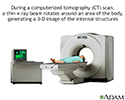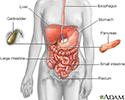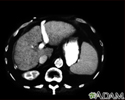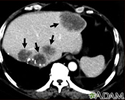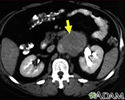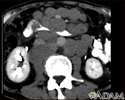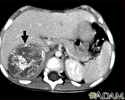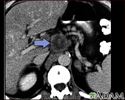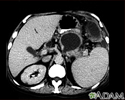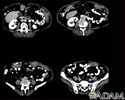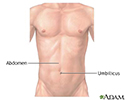Abdominal CT scan
Computed tomography scan - abdomen; CT scan - abdomen; CT abdomen and pelvis
An abdominal CT scan is an imaging method. This test uses x-rays to create cross-sectional pictures of the belly area. CT stands for computed tomography.
How the Test is Performed
You will lie on a narrow table that slides into the center of the CT scanner. Most often, you will lie on your back with your arms raised above your head.
Once you are inside the scanner, the machine's x-ray beam rotates around you. Modern spiral scanners can perform the exam without stopping.
A computer creates separate images of the belly area. These are called slices. These images can be stored, viewed on a monitor, printed on film or saved to a disk. Three-dimensional models of the belly area can be made by stacking the slices together.
You must be still during the exam, because movement causes blurred images. You may be told to hold your breath for short periods of time.
In many cases, an abdominal CT is done with a pelvis CT.
The scan should take less than 30 minutes.
How to Prepare for the Test
You need to have a special dye, called contrast, put into your body before some exams. Contrast helps certain areas show up better on the scans. Contrast can be administered in various ways. Such as:
- Contrast can be given through a vein (IV) in your hand or forearm. If contrast is used, you may also be asked not to eat or drink anything for 4 to 6 hours before the test.
- You may have to drink the contrast before the exam. When you drink it will depend on the type of exam being done. Contrast has a chalky taste, although some are flavored so they taste a little better. The contrast you drink will pass out of your body through your stools and is harmless.
Let your health care provider know if you have ever had a reaction to contrast. You may need to take medicines before the test to safely receive this substance.
Before receiving the contrast, tell your provider if you take the diabetes medicine metformin (Glucophage). People taking this medicine may have to stop taking it for a while before the test.
Let your provider know if you have any kidney problems. The IV contrast can worsen kidney function.
Too much weight can damage the scanner. Find out if the CT machine has a weight limit if you weigh more than 300 pounds (135 kg).
You will need to take off your jewelry and wear a hospital gown during the study.
How the Test will Feel
Lying on the hard table may be a bit uncomfortable.
If you have contrast through a vein (IV), you may have:
- Slight burning sensation
- Metallic taste in the mouth
- Warm flushing of the body
These feelings are normal and go away within a few seconds.
Why the Test is Performed
An abdominal CT scan makes detailed pictures of the structures inside your belly very quickly.
This test may be used to look for:
- Cause of blood in the urine
- Cause of abdominal pain or swelling
- Cause of abnormal blood test results such as liver or kidney problems
- Hernia
- Cause of a fever
- Masses and tumors, including cancer
- Infections or injury
- Kidney stones
- Appendicitis
What Abnormal Results Mean
The abdominal CT scan may show some cancers, including:
- Cancer of the renal pelvis or ureter
- Colon cancer
- Hepatocellular carcinoma
- Lymphoma
- Melanoma
- Ovarian cancer
- Pancreatic cancer
- Pheochromocytoma
- Renal cell carcinoma (kidney cancer)
- Spread of cancers that began outside the belly
The abdominal CT scan may show problems with the gallbladder, liver, or pancreas, including:
- Acute cholecystitis
- Alcoholic liver disease
- Cholelithiasis
- Pancreatic abscess
- Pancreatic pseudocyst
- Pancreatitis
- Blockage of bile ducts
The abdominal CT scan may reveal the following kidney problems:
- Blockage of the kidneys
- Hydronephrosis (kidney swelling from the backflow of urine)
- Kidney infection
- Kidney stones
- Kidney or ureter damage
- Polycystic kidney disease
Abnormal results may also be due to:
- Abdominal aortic aneurysm
- Abscesses
- Appendicitis
- Bowel wall thickening
- Crohn disease
- Renal artery stenosis
- Renal vein thrombosis
Risks
Risks of CT scans include:
- Allergy to contrast dye
- Exposure to radiation
- Damage to kidney function from contrast dye
CT scans expose you to more radiation than regular x-rays. Many x-rays or CT scans over time may increase your risk for cancer. However, the risk from any one scan is small. Most modern scanners are able to reduce the radiation exposure. Talk to your provider about this risk and the benefit of the test for getting a correct diagnosis of your medical problem.
Some people have allergies to contrast dye. Let your provider know if you have ever had an allergic reaction to injected contrast dye.
The most common type of contrast given into a vein contains iodine. If you have an iodine allergy, you may have nausea or vomiting, sneezing, itching, or hives if you get this type of contrast. If you must be given such contrast, your provider may give you antihistamines (such as Benadryl) or steroids before the test.
Your kidneys help remove IV dye from the body. You may need extra fluids after the test to help flush the iodine out of your body if you have kidney disease or diabetes.
Rarely, the dye may cause a life-threatening allergic response. Tell the scanner operator right away if you have any trouble breathing during the test. Scanners come with an intercom and speakers, so the operator can hear you at all times.
References
Al Sarraf AA, McLaughlin PD, Maher MM. Current status of imaging of the gastrointestinal tract. In: Adam A, Dixon AK, Gillard JH, Schaefer-Prokop CM, eds. Grainger & Allison's Diagnostic Radiology: A Textbook of Medical Imaging. 7th ed. Philadelphia, PA: Elsevier; 2021:chap 18.
Levin MS, Gore RM. Diagnostic imaging procedures in gastroenterology. In: Goldman L, Schafer AI, eds. Goldman-Cecil Medicine. 26th ed. Philadelphia, PA: Elsevier; 2020:chap 124.
Martinez JP. Abdominal pain. In: Walls RM, ed. Rosen's Emergency Medicine: Concepts and Clinical Practice. 10th ed. Philadelphia, PA: Elsevier; 2023:chap 23.
CT scan - illustration
CT scan
illustration
Digestive system - illustration
Digestive system
illustration
Liver cirrhosis - CT scan - illustration
Liver cirrhosis - CT scan
illustration
Liver metastases, CT scan - illustration
Liver metastases, CT scan
illustration
Lymph node metastases, CT scan - illustration
Lymph node metastases, CT scan
illustration
Lymphoma, malignant - CT scan - illustration
Lymphoma, malignant - CT scan
illustration
Neuroblastoma in the liver - CT scan - illustration
Neuroblastoma in the liver - CT scan
illustration
Pancreatic cancer, CT scan - illustration
Pancreatic cancer, CT scan
illustration
Pancreatic pseudocyst - CT scan - illustration
Pancreatic pseudocyst - CT scan
illustration
Peritoneal and ovarian cancer, CT scan - illustration
Peritoneal and ovarian cancer, CT scan
illustration
Spleen metastasis - CT scan - illustration
Spleen metastasis - CT scan
illustration
Normal external abdomen - illustration
Normal external abdomen
illustration
CT scan - illustration
CT scan
illustration
Digestive system - illustration
Digestive system
illustration
Liver cirrhosis - CT scan - illustration
Liver cirrhosis - CT scan
illustration
Liver metastases, CT scan - illustration
Liver metastases, CT scan
illustration
Lymph node metastases, CT scan - illustration
Lymph node metastases, CT scan
illustration
Lymphoma, malignant - CT scan - illustration
Lymphoma, malignant - CT scan
illustration
Neuroblastoma in the liver - CT scan - illustration
Neuroblastoma in the liver - CT scan
illustration
Pancreatic cancer, CT scan - illustration
Pancreatic cancer, CT scan
illustration
Pancreatic pseudocyst - CT scan - illustration
Pancreatic pseudocyst - CT scan
illustration
Peritoneal and ovarian cancer, CT scan - illustration
Peritoneal and ovarian cancer, CT scan
illustration
Spleen metastasis - CT scan - illustration
Spleen metastasis - CT scan
illustration
Normal external abdomen - illustration
Normal external abdomen
illustration
Review Date: 7/5/2022
Reviewed By: Jason Levy, MD, FSIR, Northside Radiology Associates, Atlanta, GA. Also reviewed by David C. Dugdale, MD, Medical Director, Brenda Conaway, Editorial Director, and the A.D.A.M. Editorial team.














